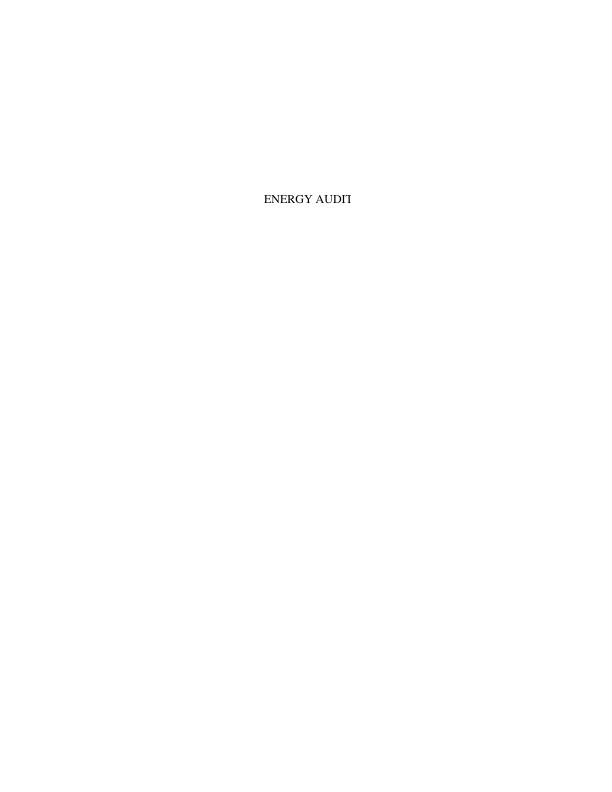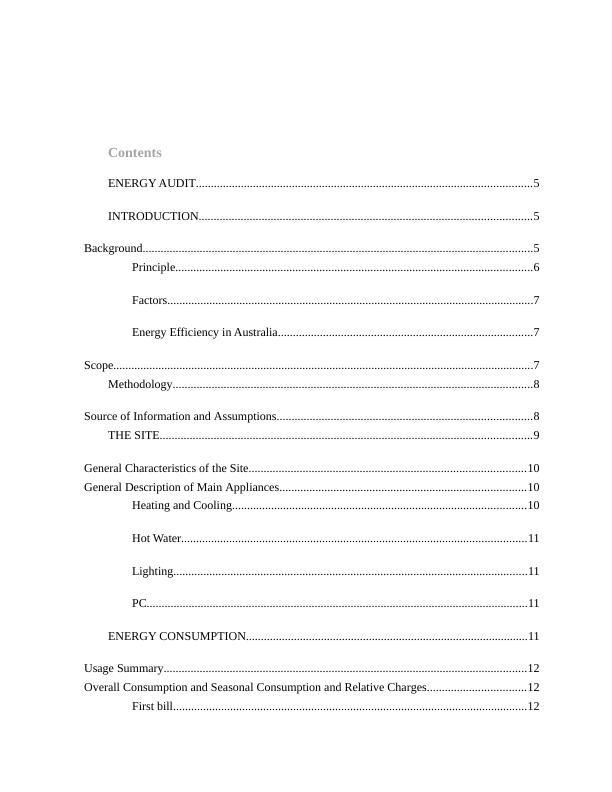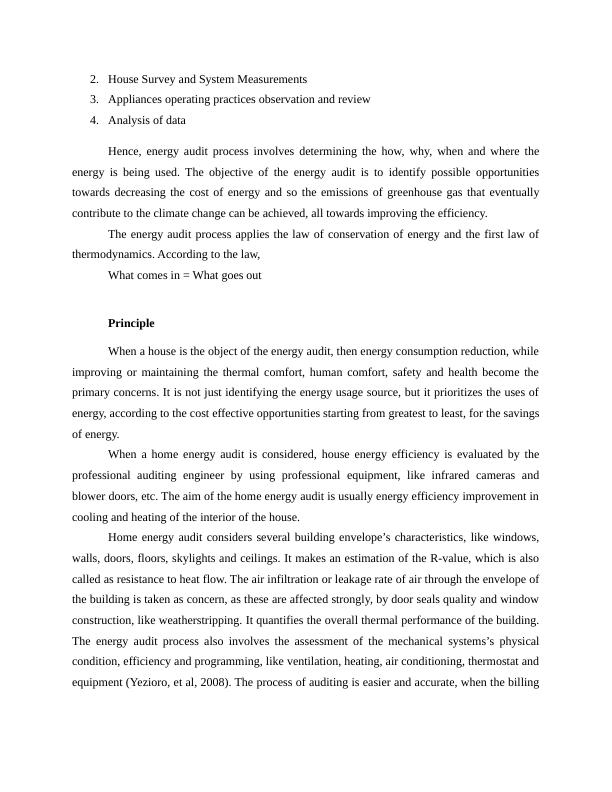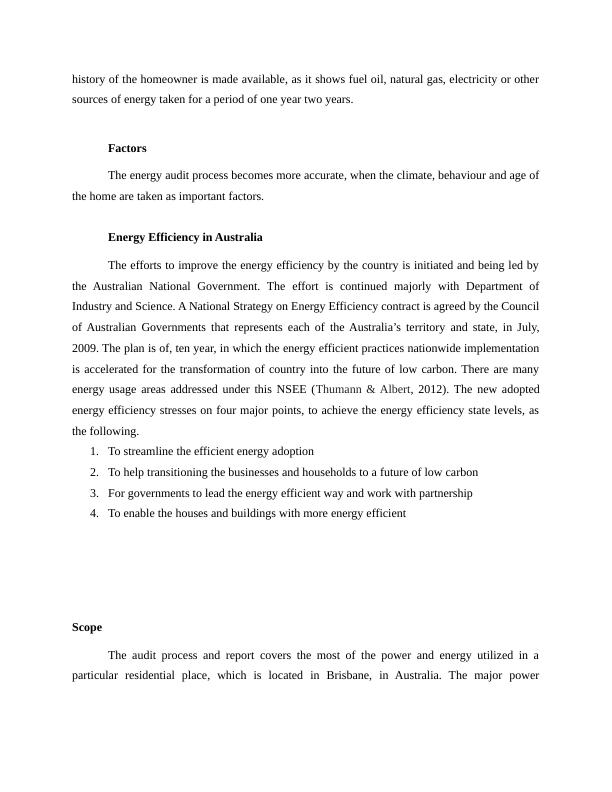Energy Audit for Residential House in Brisbane, Australia
Write an energy audit report for a residential area, including power summary, introduction, methodology, energy consumption analysis, and recommendations.
30 Pages8280 Words433 Views
Added on 2023-06-12
About This Document
This report covers the energy audit process, methodology, and recommendations for a residential house in Brisbane, Australia. The report includes information on the energy efficiency in Australia, factors affecting energy audit, and general characteristics of the site. The report also covers the main appliances, heating and cooling systems, energy consumption, audit measurements and calculations, energy management opportunities, and other recommendations including an action plan.
Energy Audit for Residential House in Brisbane, Australia
Write an energy audit report for a residential area, including power summary, introduction, methodology, energy consumption analysis, and recommendations.
Added on 2023-06-12
ShareRelated Documents

Contents
ENERGY AUDIT................................................................................................................5
INTRODUCTION...............................................................................................................5
Background..................................................................................................................................5
Principle.......................................................................................................................6
Factors..........................................................................................................................7
Energy Efficiency in Australia.....................................................................................7
Scope............................................................................................................................................7
Methodology........................................................................................................................8
Source of Information and Assumptions.....................................................................................8
THE SITE............................................................................................................................9
General Characteristics of the Site............................................................................................10
General Description of Main Appliances..................................................................................10
Heating and Cooling..................................................................................................10
Hot Water...................................................................................................................11
Lighting......................................................................................................................11
PC...............................................................................................................................11
ENERGY CONSUMPTION..............................................................................................11
Usage Summary.........................................................................................................................12
Overall Consumption and Seasonal Consumption and Relative Charges.................................12
First bill......................................................................................................................12
ENERGY AUDIT................................................................................................................5
INTRODUCTION...............................................................................................................5
Background..................................................................................................................................5
Principle.......................................................................................................................6
Factors..........................................................................................................................7
Energy Efficiency in Australia.....................................................................................7
Scope............................................................................................................................................7
Methodology........................................................................................................................8
Source of Information and Assumptions.....................................................................................8
THE SITE............................................................................................................................9
General Characteristics of the Site............................................................................................10
General Description of Main Appliances..................................................................................10
Heating and Cooling..................................................................................................10
Hot Water...................................................................................................................11
Lighting......................................................................................................................11
PC...............................................................................................................................11
ENERGY CONSUMPTION..............................................................................................11
Usage Summary.........................................................................................................................12
Overall Consumption and Seasonal Consumption and Relative Charges.................................12
First bill......................................................................................................................12

Second bill.................................................................................................................13
Seasonal Charges of Energy Consumption................................................................................15
Energy Use Assumptions...........................................................................................................16
Appliances.................................................................................................................16
AUDIT MEASUREMENTS AND CALCULATIONS.....................................................17
Overall Summary of Energy of Consumption...........................................................................18
Energy Usage by Application....................................................................................................18
Pie Chart of Breakdown of Energy Consumption.....................................................................19
Bill Details.................................................................................................................................19
ENERGY MANAGEMENT OPPORTUNITIES..............................................................20
Lighting......................................................................................................................................20
Heating and Cooling..................................................................................................................21
OTHER RECOMMENDATIONS INCLUDING ACTION PLAN..................................21
CONCLUSION..................................................................................................................23
REFERENCES..................................................................................................................24
APPENDIX........................................................................................................................27
TABLE 1 - LIGHT READINGS WITH LUX METER............................................................27
TABLE 2 – ESTIMATED CALCUATIONS FOR LIGHTNING USAGE.............................29
TABLE 3 – ESTIMATED ENERGY USAGE.........................................................................30
Seasonal Charges of Energy Consumption................................................................................15
Energy Use Assumptions...........................................................................................................16
Appliances.................................................................................................................16
AUDIT MEASUREMENTS AND CALCULATIONS.....................................................17
Overall Summary of Energy of Consumption...........................................................................18
Energy Usage by Application....................................................................................................18
Pie Chart of Breakdown of Energy Consumption.....................................................................19
Bill Details.................................................................................................................................19
ENERGY MANAGEMENT OPPORTUNITIES..............................................................20
Lighting......................................................................................................................................20
Heating and Cooling..................................................................................................................21
OTHER RECOMMENDATIONS INCLUDING ACTION PLAN..................................21
CONCLUSION..................................................................................................................23
REFERENCES..................................................................................................................24
APPENDIX........................................................................................................................27
TABLE 1 - LIGHT READINGS WITH LUX METER............................................................27
TABLE 2 – ESTIMATED CALCUATIONS FOR LIGHTNING USAGE.............................29
TABLE 3 – ESTIMATED ENERGY USAGE.........................................................................30

INTRODUCTION
An energy audit is a process with viable and potential survey of inspection for the energy
flows anlaysis for performing energy conservation, in a particular house or in a system. The
objective of the audit system is to reduce the total energy input into the system with no negative
output affects.
The path of energy audit directs to the energy efficiency implementation. Inefficient and
potentially huge energy consumed equipment has to be replaced with efficient equipment. The
goal of the energy audit is to save and reduce the kilowatt hours (kWh) and kilowatts (kW).
There is a small difference between such two measurements. Here, kilowatt is measured as
power rating and kilowatt hours is the actual consumed energy measurement. Energy efficiency
implementation results in reduced carbon footprint, through reducing the operational costs. The
overall benefit of the energy audit and the expected outcome of energy efficiency
implementation is to improve the quality of life. It plays a vital role to increase the revenue, in
case the consumers make use of the greener product, in the place of non-greener product
(Forsstrom, et al, 2011). Though a house is considered as a basic unit, small changes and the
respective changes in the home energy consumption, can add up to larger savings. The overall
benefits of the same are to decrease the operational costs, carbon footprint to increase or improve
the quality of life.
Background
The power consumption by every electrical appliance, in every house has direct contact
and effect to the greenhouse gasses and so carbon footprint. Hence, every house has been taken
as a basic unit to calculate the contribution of the greenhouse gas emission, by each house. The
process of calculating the power consumption in a house is done through the process of energy
audit. And the energy audit program stands as the key to the program of the energy management.
The process of energy audit has the following stages (Barbara & Wolfgang, 2012).
1. Collection of data and review of the same
An energy audit is a process with viable and potential survey of inspection for the energy
flows anlaysis for performing energy conservation, in a particular house or in a system. The
objective of the audit system is to reduce the total energy input into the system with no negative
output affects.
The path of energy audit directs to the energy efficiency implementation. Inefficient and
potentially huge energy consumed equipment has to be replaced with efficient equipment. The
goal of the energy audit is to save and reduce the kilowatt hours (kWh) and kilowatts (kW).
There is a small difference between such two measurements. Here, kilowatt is measured as
power rating and kilowatt hours is the actual consumed energy measurement. Energy efficiency
implementation results in reduced carbon footprint, through reducing the operational costs. The
overall benefit of the energy audit and the expected outcome of energy efficiency
implementation is to improve the quality of life. It plays a vital role to increase the revenue, in
case the consumers make use of the greener product, in the place of non-greener product
(Forsstrom, et al, 2011). Though a house is considered as a basic unit, small changes and the
respective changes in the home energy consumption, can add up to larger savings. The overall
benefits of the same are to decrease the operational costs, carbon footprint to increase or improve
the quality of life.
Background
The power consumption by every electrical appliance, in every house has direct contact
and effect to the greenhouse gasses and so carbon footprint. Hence, every house has been taken
as a basic unit to calculate the contribution of the greenhouse gas emission, by each house. The
process of calculating the power consumption in a house is done through the process of energy
audit. And the energy audit program stands as the key to the program of the energy management.
The process of energy audit has the following stages (Barbara & Wolfgang, 2012).
1. Collection of data and review of the same

2. House Survey and System Measurements
3. Appliances operating practices observation and review
4. Analysis of data
Hence, energy audit process involves determining the how, why, when and where the
energy is being used. The objective of the energy audit is to identify possible opportunities
towards decreasing the cost of energy and so the emissions of greenhouse gas that eventually
contribute to the climate change can be achieved, all towards improving the efficiency.
The energy audit process applies the law of conservation of energy and the first law of
thermodynamics. According to the law,
What comes in = What goes out
Principle
When a house is the object of the energy audit, then energy consumption reduction, while
improving or maintaining the thermal comfort, human comfort, safety and health become the
primary concerns. It is not just identifying the energy usage source, but it prioritizes the uses of
energy, according to the cost effective opportunities starting from greatest to least, for the savings
of energy.
When a home energy audit is considered, house energy efficiency is evaluated by the
professional auditing engineer by using professional equipment, like infrared cameras and
blower doors, etc. The aim of the home energy audit is usually energy efficiency improvement in
cooling and heating of the interior of the house.
Home energy audit considers several building envelope’s characteristics, like windows,
walls, doors, floors, skylights and ceilings. It makes an estimation of the R-value, which is also
called as resistance to heat flow. The air infiltration or leakage rate of air through the envelope of
the building is taken as concern, as these are affected strongly, by door seals quality and window
construction, like weatherstripping. It quantifies the overall thermal performance of the building.
The energy audit process also involves the assessment of the mechanical systems’s physical
condition, efficiency and programming, like ventilation, heating, air conditioning, thermostat and
equipment (Yezioro, et al, 2008). The process of auditing is easier and accurate, when the billing
3. Appliances operating practices observation and review
4. Analysis of data
Hence, energy audit process involves determining the how, why, when and where the
energy is being used. The objective of the energy audit is to identify possible opportunities
towards decreasing the cost of energy and so the emissions of greenhouse gas that eventually
contribute to the climate change can be achieved, all towards improving the efficiency.
The energy audit process applies the law of conservation of energy and the first law of
thermodynamics. According to the law,
What comes in = What goes out
Principle
When a house is the object of the energy audit, then energy consumption reduction, while
improving or maintaining the thermal comfort, human comfort, safety and health become the
primary concerns. It is not just identifying the energy usage source, but it prioritizes the uses of
energy, according to the cost effective opportunities starting from greatest to least, for the savings
of energy.
When a home energy audit is considered, house energy efficiency is evaluated by the
professional auditing engineer by using professional equipment, like infrared cameras and
blower doors, etc. The aim of the home energy audit is usually energy efficiency improvement in
cooling and heating of the interior of the house.
Home energy audit considers several building envelope’s characteristics, like windows,
walls, doors, floors, skylights and ceilings. It makes an estimation of the R-value, which is also
called as resistance to heat flow. The air infiltration or leakage rate of air through the envelope of
the building is taken as concern, as these are affected strongly, by door seals quality and window
construction, like weatherstripping. It quantifies the overall thermal performance of the building.
The energy audit process also involves the assessment of the mechanical systems’s physical
condition, efficiency and programming, like ventilation, heating, air conditioning, thermostat and
equipment (Yezioro, et al, 2008). The process of auditing is easier and accurate, when the billing

history of the homeowner is made available, as it shows fuel oil, natural gas, electricity or other
sources of energy taken for a period of one year two years.
Factors
The energy audit process becomes more accurate, when the climate, behaviour and age of
the home are taken as important factors.
Energy Efficiency in Australia
The efforts to improve the energy efficiency by the country is initiated and being led by
the Australian National Government. The effort is continued majorly with Department of
Industry and Science. A National Strategy on Energy Efficiency contract is agreed by the Council
of Australian Governments that represents each of the Australia’s territory and state, in July,
2009. The plan is of, ten year, in which the energy efficient practices nationwide implementation
is accelerated for the transformation of country into the future of low carbon. There are many
energy usage areas addressed under this NSEE (Thumann & Albert, 2012). The new adopted
energy efficiency stresses on four major points, to achieve the energy efficiency state levels, as
the following.
1. To streamline the efficient energy adoption
2. To help transitioning the businesses and households to a future of low carbon
3. For governments to lead the energy efficient way and work with partnership
4. To enable the houses and buildings with more energy efficient
Scope
The audit process and report covers the most of the power and energy utilized in a
particular residential place, which is located in Brisbane, in Australia. The major power
sources of energy taken for a period of one year two years.
Factors
The energy audit process becomes more accurate, when the climate, behaviour and age of
the home are taken as important factors.
Energy Efficiency in Australia
The efforts to improve the energy efficiency by the country is initiated and being led by
the Australian National Government. The effort is continued majorly with Department of
Industry and Science. A National Strategy on Energy Efficiency contract is agreed by the Council
of Australian Governments that represents each of the Australia’s territory and state, in July,
2009. The plan is of, ten year, in which the energy efficient practices nationwide implementation
is accelerated for the transformation of country into the future of low carbon. There are many
energy usage areas addressed under this NSEE (Thumann & Albert, 2012). The new adopted
energy efficiency stresses on four major points, to achieve the energy efficiency state levels, as
the following.
1. To streamline the efficient energy adoption
2. To help transitioning the businesses and households to a future of low carbon
3. For governments to lead the energy efficient way and work with partnership
4. To enable the houses and buildings with more energy efficient
Scope
The audit process and report covers the most of the power and energy utilized in a
particular residential place, which is located in Brisbane, in Australia. The major power

End of preview
Want to access all the pages? Upload your documents or become a member.
Related Documents
Ventilated Slab Cooling System and Energy Efficiency in Buildingslg...
|31
|8397
|429
Development of Sustainable Home using Net Zero Energylg...
|28
|2719
|339
Improving Energy Efficiency: Analysis of Household and Possible Alternativeslg...
|12
|3174
|193
Greenhouse Principles of Sustainabilitylg...
|26
|1645
|62
Energy Efficiencylg...
|10
|1716
|499
Energy Consumption Control in De Montfort Universitylg...
|16
|3427
|11
